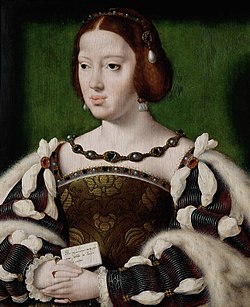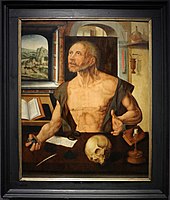Joos van Cleve

Joos van Cleve (/ˈkleɪvə/;[1] also Joos van der Beke; c. 1485–1490 – 1540/1541) was a leading painter active in Antwerp from his arrival there around 1511 until his death in 1540 or 1541. Within Dutch and Flemish Renaissance painting, he combines the traditional techniques of Early Netherlandish painting with influences of more contemporary Renaissance painting styles.[2]
An active member and co-deacon of the Guild of Saint Luke of Antwerp, he is known mostly for his religious works and portraits, some of royalty. He ran a large workshop, with at least five pupils and other assistants, which produced paintings in a variety of styles over his career.[3] As a skilled technician, his art shows sensitivity to color and a unique solidarity of figures.[4] His style is highly eclectic: he was one of the first to introduce broad world landscapes in the backgrounds of his paintings, sometimes collaborating with Joachim Patinir, which would become a popular technique of sixteenth century northern Renaissance paintings. Some works reflect the popular style of Antwerp Mannerism, while others are variations on early Netherlandish masters of two or more generations before, or reflect recent Italian painting.[5]
Four of his more important paintings have the
He was the father of Cornelis van Cleve (1520–1567) who also became a painter, and inherited the workshop.[9] Cornelis became mentally ill during a residence in England and was therefore referred to as 'Sotte Cleef' (mad Cleef).[7][10]
Life

Joos van Cleve was born around 1485–90. The birthplace of Joos van Cleve is not precisely known. In various Antwerp legal documents he is referred to as 'Joos van der Beke alias van Cleve'. It is therefore likely that he came from the Lower Rhenish region or city named Kleve (in traditional English "Cleves"), from which his name is derived. It is assumed that he began his artistic training around 1505 in the workshop of Jan Joest, whom he assisted in the panel paintings of the wings for the high altar of the Nikolaikirche in Kalkar, Lower Rhine, Germany,[11] from 1506 to 1509. These include one of his self-portraits. From this a birth date of about 1485 to 1490 is inferred.[12]
Joos van Cleve is believed to have moved to Bruges between 1507 and 1511 since his painting style is similar to that of the painters of Bruges.[10] Later he moved to Antwerp, and in 1511 became a free master in the Antwerp Guild of Saint Luke. He was co-deacon of the guild for several years around 1520, along with registering pupils there at various dates between 1516 and 1536.[7] In 1528 he bought a house from his wife's parents. As there are no records of his being in Antwerp between 1529 and 1534, it is possible he spent some of this time in Italy or France at the court, or even London.[13][10]
From surviving documents it is clear that he was alive in Antwerp on 10 November 1540 and dead by 4 February 1541.[14]
Personal life
He had two children from his first marriage, a daughter and a son. His son named Cornelis (1520) became a painter. Although the date of his death is unknown, Joos van Cleve drew up a will and testament on 10 November 1540, and his second wife was listed as a widow in April 1541.[7]
There are a number of other "van Cleef" Antwerp painters recorded from his time, some of whom may have been relatives.
Work

Compositions were often copied, repeated or adapted; for example at least six versions of an Adoration of the Magi triptych composition by him and his workshop are known, though varying considerably in size, with the widths of the centre panel ranging from 56 to 93 cm.[9] This probably reflected different intended sites for the paintings, from private house chapels to churches.[15]
Numerous paintings contain
The great majority of his work is religious subjects or portraits, with the main exceptions being versions of the Suicide of
In January 2021 an episode the BBC Four series Britain's Lost Masterpieces, centred on the fine art collection of the Royal Pavilion in Brighton, uncovered a work of Joos van Cleve, a portrayal of Balthazar, previously attributed to Bernard van Orley. The painting had once been the left-hand door of a folding altarpiece triptych.[17][18]
-
The Last Judgment, oil on panel, 123.8 cm (48.7 in) high
-
Salvator Mundi, c.1516-18, Louvre
-
Annunciation; Italianate figure style, with the Early Netherlandish domestic setting of works such as the Mérode Altarpiece of Robert Campin, c. 1525
-
Portrait ofEleonore of Austria, Queen of France, c. 1530
Artistic influences
The influence of Kalkar and Bruges are seen in many of Joos van Cleve's early works, such as Adam and Eve (1507). The Death of the Virgin (1520) shows the combined influence of several artists. It has the intense emotionality of Hugo van der Goes, and iconographic ideas of Jan van Eyck and Robert Campin. A strong influence of Italian art combined with Joos van Cleve's own color and light sensitivity make his works especially unique. The "Antwerp Mannerist" style is identifiable in the Adoration of the Magi. It is thought that the "Antwerp Mannerists" were in turn influenced by Joos van Cleve.
Like Quentin Matsys, a fellow artist active in Antwerp, Joos van Cleve appropriated themes and techniques of Leonardo da Vinci. This is apparent in the use of sfumato in the Virgin and Child. Multiple versions of a soft, sentimental Madonna and Child and the Holy Family were discovered, produced in his workshop.[7]
Royal portraits
Joos van Cleve's skills as a portrait artist were highly regarded as demonstrated by a summons to the court of
Virgin and Child and Holy Family

Small devotional pictures of the
The Holy Family was a newly popular subject in small devotional paintings, reflecting increased theological and devotional interest in the role of
Another of the many compositional types exists in very similar versions, one in the
A new devotional type of the Virgin alone, her hands clasped in prayer, also appears in many versions. This may be called a
-
Madonna and Sleeping Child in a Landscape, 1515–1520
-
Genoa, Palazzo Bianco
-
Leonardo-esque Madonna of the Cherries, Berlin, c. 1525
-
Fitzwilliam Museum, c. 1525–30
-
With wine-drinking Child, sold Sotheby's, 2014
-
The Virgin in Prayer,Minneapolis Institute of Arts
-
The Virgin in Prayer, Yale
-
Another Holy Family type found in many versions
Saint Jerome

Paintings of Saint Jerome were produced by Joos and his workshop, apparently beginning in 1521, in three basic types: penitent amid a desert landscape, with his attribute of a lion; at bust or half-length in a cluttered study, often with a skull on his desk; and lastly in his study, naked to the waist and holding a rock. The first two are not original, and borrow in particular from
-
Saint Jerome in Penitence
-
The second type described here
-
Saint Jerome in His Study, 1528, Princeton, with HOMO BULLA ("Man is a bubble") on the wall.
-
In his study, with a rock
Works (very incomplete list)

In chronological order
- The Holy Family (1515), Akademie der bildenden Kunste, Vienna
- Saint Reinhold Altar (before 1516), National Museum, Warsaw
- Descent from the Cross (c. 1517–20), Philadelphia Museum of Art[26]
- Triptych. Centre: the Deposition from the Cross; Left wing: St John the Baptist with a Donor; Right wing: St Margaret of Antioch with a Donatrix (1518–1519), National Galleries Scotland, Edinburgh[27]
- Self-Portrait (1519), Museo Thyssen-Bornemisza, Madrid
- The Death of the Virgin (1520), Alte Pinakothek, Munich
- Man with the Rosary (1520), National Museum of Serbia[28]
- Altarpiece of the Lamentation (1520–25), Musée du Louvre, Paris
- Lucretia (1520–25), Kunsthistorisches Museum, Vienna[29]
- Madonna of the Cherries (c1525), Bristol Museum and Art Gallery, Bristol, UK.
- St. John the Evangelist on Patmos (1525), University of Michigan Museum of Art, Ann Arbor
- Portrait of a Man and Woman (1520 and 1527), Galleria degli Uffizi, Florence
- The Annunciation [1] (1525), Metropolitan Museum of Art, New York
- The Infants Christ and Saint John the Baptist Embracing (1525–30), Art Institute, Chicago
- Adoration of the Magi (1526–28), Gemaldegalerie, Dresden
- Saint Jerome in his Study (1528), Vassar College, Frances Lehman Loeb Art Center, Poughkeepsie, New York
- Portrait of Eleonora, Queen of France (1530), Kunsthistorisches Museum, Vienna
- Virgin and Child (1535), Landesmuseum, Oldenburg
- Madonna and Child against the renaissance background (c. 1535),
Dates unknown
- Death of the Virgin, Wallraf-Richartz Museum, Cologne
- The Holy Family, The Hermitage, St. Petersburg
- Mona Vanna, National Gallery, Prague
- Portrait of Agniete ven den Rijne, Rijksmuseum Twenthe, Enschede
- Portrait of Anthonis van Hilten, Rijksmuseum Twenthe, Enschede
- St. Anne with the Virgin and Child and St. Joachim, Musee Royaux des Beaux-Arts, Brussels
- Virgin and Child, Szepmuveszeti Muzeum, Budapest
- Triptych of Saint Peter, Saint Paul and Saint Andrew, Museu de Arte Sacra do Funchal
Notes
- ^ "Cleve". Random House Webster's Unabridged Dictionary.
- ^ "Rijksmuseum: Joos van Cleve". Archived from the original on 3 February 2012. Retrieved 20 April 2011.
- ^ Leeflang, 62–63, 71
- ISBN 0-300-10578-9.
- ^ Snyder, 412–418
- ^ Leeflang, 61–63, 71
- ^ ISBN 0-300-07701-7.
- ^ Hand, 4
- ^ a b c Leeflang, 63
- ^ a b c Joos van Cleve at the Netherlands Institute for Art History (in Dutch)
- ^ John Oliver Hand. "Cleve, van (i)." Grove Art Online. Oxford Art Online. Oxford University Press. Web. 25 March 2015
- ^ Leeflang, 62–63; Hand, 3
- ^ Hand, 3
- ^ Leeflang, 62–63
- ^ Leeflang, 71
- ^ Leeflang, 69–71
- ^ "Britain's Lost Masterpieces – Series 5: 1. Brighton" – via www.bbc.co.uk.
- ^ "Balthazar | Art UK".
- ^ Snyder, 418
- ^ Joos van Cleve (active 1505/08-1540/41), Henry VIII at the Royal Collection
- ISBN 0136235964
- ^ ""The Holy Family", New York Metropolitan Museum of Art". Metmuseum.org. Retrieved 15 January 2019.
- ^ Virgin and Child at Sotheby's
- ^ Hand, 8
- ^ Hand, 4–8
- ^ Bay, Lucia, and Christopher D. M. Atkins. "Descent from the Cross by Joos van Cleve (cat. 373)". The John G. Johnson Collection: A History and Selected Works. A Philadelphia Museum of Art free digital publication.
{{cite web}}: CS1 maint: multiple names: authors list (link) - ^ Triptych. Centre: the Deposition from the Cross; Left wing: St John the Baptist with a Donor; Right wing: St Margaret of Antioch with a Donatrix (1518–1519), National Galleries Scotland, Edinburgh
- ^ "Man with the Rosary (1520), National Museum, Belgrade". Archived from the original on 2 October 2011.
- ^ "Kunsthistorisches Museum / Lucretia". Kunsthistorisches Museum. Retrieved 14 January 2024.
References
- Hand, John Oliver. ""Saint Jerome in His Study" by Joos Van Cleve." Record of the Art Museum, Princeton University 49, no. 2 (1990): 3–10. Accessed January 4, 2021. doi:10.2307/3774675, JSTOR
- Leeflang, Micha. "Joos Van Cleve's "Adoration of the Magi" in Detroit: Revealing the Underdrawing," Bulletin of the Detroit Institute of Arts 82, no. 1/2 (2008): 60–75. Accessed January 3, 2021. JSTOR
- ISBN 0136235964
External links
 Media related to Joos van Cleve at Wikimedia Commons
Media related to Joos van Cleve at Wikimedia Commons

![Descent from the Cross, Rogier van der Weyden's figures (Prado), given a landscape background.[19]](http://upload.wikimedia.org/wikipedia/commons/thumb/3/3e/Cat373-cons2017.jpg/250px-Cat373-cons2017.jpg)
















